
Birth of a General: The General Motors Story | Reading Room BY WILLIAM PELFREY |
BILLY TAKES ANOTHER CALL
The biggest adventure of all began with what Billy described as an unexpected phone call from Chicago. The caller was Ben Briscoe, who had established close relations with the all-powerful House of Morgan in New York City after dumping his interest in the failing Buick enterprise on James Whiting in 1904. J.P. Morgan and Company agreed to back Briscoe with a bond issue of $250,000 to acquire Jonathan Maxwell's automobile enterprise, which at the time was only slightly healthier than David Dunbar Buick's business. The Morgan bankers were finally taking notice of the automobile industry's potential and saw the underwriting of Briscoe as a low-risk way to enter the market. The also wanted to make sure that the concentration of manufacturing operations in the Midwest was offset by at least one major operation in the East. At the insistence of Morgan, the renamed Maxwell-Briscoe Company proceeded to build a new plant in Tarrytown, New York, on the banks of the Hudson River. Within a year, the plant was up and running. The first Maxwell-Briscoe cars were immediately successful, but by the spring of 1908, Briscoe (like so many others) was convinced that the inevitable shakeout among manufactures would come sooner rather than later. Accordingly, he had an idea to run by Billy Durant. As Billy described it: "I was dining with my daughter, Mrs. E.R. Campbell, when I was called to the phone. Chicago on the line, Briscoe calling." Durant told Briscoe he couldn't come to Chicago, he was too busy; but he would have breakfast with him in the morning if Briscoe could catch the evening train to Flint. Briscoe agreed, and Billy met him at the Flint train depot at seven o'clock the next morning. They had a quick breakfast at the nearby Dresden Hotel and then proceeded to Billy's office at the Buick plant to discuss Briscoe's big idea. The idea was a consolidation of carmakers on the lines of U.S. Steel, whose creation in 1901 had been orchestrated by J.P. Morgan himself. Morgan now wanted Briscoe to feel Durant out on the idea of a similar automotive merger. As Billy recalled it: One of the partners of J.P. Morgan and Co. had made a small investment in the Maxwell-Briscoe Co. when it was first organized. Pleased with progress the company was making and recognizing the possibilities, he asked me if a sufficient number of motor car concerns could be brought together to control the industry. How would the leading companies regard a consolidation? Would Briscoe canvass the situation and report [to Morgan]? At that time trusts and combinations were the order of the day -- promotions of all kinds encouraged by big banking interests. Biscoe had no well-considered plan but wanted to get my ideas. Despite his years as a professional stock trader in New York before taking on the Buick challenge, there is no record of Billy Durant having ever dealt directly with the House of Morgan before Briscoe made his pitch. If he had, he may well have told Briscoe good-bye on the spot. Durant's business record (like that of all the other strong-willed auto industry leaders of the day) indicates a temperament that would never willingly cough up the kind of money and operational control that was the J.P. Morgan and Company policy in underwriting mergers. That policy was spelled out by Morgan partner George Perkins, who eventually became the lead intermediary in trying to put together the first automotive merger: "Morgan and Company would investigate, consulting and questioning the various producers in the field as to their interests and opinions. Then the firm would prepare a plan and submit it to the chief corporations in the industry. If approved, the House of Morgan would estimate the working capital necessary to organize the new concern, and form a syndicate to raise the money. If $10,000,000 were needed, the syndicate would issue $15,000,000 in stock, the extra millions representing the syndicate's 'bonus'...Morgan would also insist upon choosing all the officers and directors of the new company. This point Morgan and Co. have found indispensable in making their combination." (Bernard A. Weinberger, "The Dream Maker," Boston: Little, Brown, 1979, p.128) Perkins's description of more than a century ago remains a remarkably accurate depiction of the way most investment banks still put deals together today. It also explains why they were feared, respected, and needed all at the same time, then as now. At this meeting with Durant in Flint, Briscoe suggested bringing together no less than twenty companies for discussions. He then asked Billy what he thought. Billy told him he did not think it was workable, with so many different parties and too many conflicting interests to be reconciled. Billy asked, "Why not modify your ideas, Ben, and see if you can get together a few concerns committed to volume production in the medium-priced class, all having a common objective, all heading for a highly competitive field?"* He went on to suggest Ford, Maxwell-Briscoe, Buick, and Reo, then the four dominant companies of the industry. (Reo had been formed by Ransom E. Olds after his falling out with his financial backer Fred Smith and his Oldsmobile management team and was now actually outselling Oldsmobile.) Durant further suggested that Briscoe meet personally with Henry Ford before any of the others, explaining that Ford was "in the limelight, liked publicity, and unless he could lead the procession, would not play."* He told Briscoe, "Get Ford if possible, then take the matter up with R.E. Olds. When and if everything is arranged to your satisfaction, advise me the time and place and I will attend your meeting."* Regardless of how much each player actually knew of the Morgan bankers' modus operandi, a new game was afoot. The fact that all the players quickly agreed to what Billy suggested that morning is testimony to how nervous and uncertain each man was about who would survive in the young but ruthlessly competitive and wide open automobile industry. BILLY BRINGS THE BIG FOUR TOGETHER... With J.P. Morgan and Company still in the background, Briscoe informed Durant two weeks after their Flint breakfast that Henry Ford and Ransom Olds would like to meet with the two of them in Detroit. The designated place was the Penobscot Building (then Detroit's tallest building, still standing and occupied today) rather than the more popular Pontchartrain Hotel, where Durant and all other self-respecting nonresident auto barons always stayed. When Billy arrived, he saw the others waiting in a crowded public area with a cadre of "associates and advisers." He immediately feared that they would draw attention and headlines. As he observed: "I sensed that unless we ran to cover, plenty of undesirable publicity was in the offing. As I had commodious quarters in the Pontchartrain Hotel and as luncheon hour was approaching, I suggested that we separate (in order not to attract attention) and meet in my room as soon as convenient, giving the number of the room and how to locate it without going to the office. This was accomplished and I had the unexpected pleasure of entertaining the entire party until mid-afternoon." Durant let Briscoe open the meeting. Not one to beat around the bush, Briscoe explained that the objective was to come up with a plan for merging the four companies that might appeal to J.P. Morgan and Company. Then came what Billy called "a painful pause." Durant himself broached the subject of the value of the companies, throwing out a figure of $10 million for Ford Motor, $6 million for Reo, and $5 million for Maxwell-Briscoe, but not offering a figure for Buick. When Briscoe finally asked what Buick was worth, Billy replied only that "the report of the appraisers and auditors and the conditions and terms of the agreement" would answer that question. With tension already in the air, the discussion then moved quickly to the nitty-gritty of all merger negotiations: How would the new entity be managed? Who would be the boss? How would the different companies be represented in management? Briscoe and Durant led the discussion, and their differing views remain a remarkably accurate summary of the debate over centralized control versus operational independence that is still conducted within large companies and among potential partners every day. As Billy Durant recalled the discussion: "Briscoe took the position that the purchasing and engineering departments should be consolidated, that the advertising and sales departments should be combined, and that a central committee should pass on all operating policies. Eerily, it was the same difference in opinion and philosophy that would eventually lead to the General Motors crisis of 1920 and the final parting of Billy Durant and Alfred Sloan. Billy also noted that Henry Ford was the only person who remained silent during the meeting. Despite the sharp difference between Durant and Briscoe, the discussion kept going, with Billy recalling, "Business conditions and the future of the industry were forecast, the hazards and uncertainties were gone into thoroughly, the desirability of a controlling organization agreed upon, the meeting breaking up with the best of feeling with a statement from Mr. Briscoe that he would see his people and report, and that, in all probability, we would be invited to meet in New York in the near future." From that point, the House of Morgan took charge of the game, and none of the players would end up happy with its rules. HENRY FORD KILLS MORGAN'S BIG DEAL The exact dates of the various meetings following that initial session in Detroit are contradicted by the various players: James Couzens, Henry Ford's point man, and Ransom Olds both left sketchy diaries that put the most intense meetings in January 1908, while Billy Durant puts them in May (around the time of his divorce and remarriage). Most historians give credence to the January time frame but also concur with Durant's recollection of the substance of the conversations. Regardless of the exact dates, the House of Morgan contacted all four principals shortly after Briscoe's report. The next meeting was arranged in New York and held at the law offices of Ward, Hayden and Satterlee at 120 Broadway rather than the fabled House of Morgan at the corner of Broad and Wall Street (opposite the New York Stock Exchange). Herbert Satterlee was a partner in the firm and happened to be J. P. Morgan's son-in-law. Satterlee led the discussion and immediately asked the kinds of questions that today make all executives wince in the presence of competitors and in the absence of their own attorneys: How much capital did each bring to the table? What would each gain by the merger? Would a consolidation attract or discourage competition? What were their objections, if any, to the merger? Significantly, only Henry Ford raised any objection. As Durant recalled, "He [Ford] thought the tendency of consolidation and control was to increase prices, which he believed would be a serious mistake. He was in favor of keeping prices down to the lowest possible point, giving the multitude the benefit of cheap transportation." Ford's comment reflected his determination to build that "universal car" for the masses, but it also reflected his lingering mistrust of financiers and other businessmen. The mistrust went back to his early failures. Those experiences actually led him to resent many of the basic tenets of capitalism itself, especially the way financiers and investors were driven by the profit motive rather than what he saw as the more noble desire to create a product that would benefit the human race. Ford expressed his bitterness and suspicion when recalling his ouster by the financial backers of the Henry Ford Company in 1902: What I most realized about business that year is this: (1) That finance is given a place ahead of work and therefore tends to kill the work . . . (2) That thinking first of money instead of work brings on fear of failure and this fear blocks every avenue of business . . . (3) That the way is clear for anyone who thinks first of service, of doing the work in the best possible way. The money influence . . . seemed to be at the bottom of most troubles . . . I was not free. I could not give full play to my ideas. Everything had to be planned to make money; the last consideration was the work. Despite his comment in Satterlee's office, Henry Ford expressed no other objection to the merger at that meeting. It was agreed by all parties, however, that the session was to be considered "purely informal," that there would be no publicity, and that none of the parties had made any kind of commitment. Billy Durant left the meeting confident that a deal would be made. That same evening, he took the train back to Flint, where he instructed his attorney John Carton to draft a proposed agreement on behalf of Buick stockholders, authorizing him to act on their behalf in exchanging their Buick shares for shares of the new company. The agreement was quickly drawn up and approved. During the spring and summer, several more meetings were held in New York as the House of Morgan proceeded with the appraisal and audit of each of the four enterprises. With new bride Catherine traveling with him and supporting his vision, Durant was again thinking and dreaming big. Sometime during this period of heated negotiations in a hot summer, Billy declared, "The time will come when 500,000 automobiles will be manufactured and sold in this country every year." To which Morgan banker George Perkins (who had so eloquently described the Morgan philosophy of business) replied: "If he has any sense he'll keep those notions to himself if he ever tries to borrow money. During one trip to New York, Billy was asked by Perkins to meet with one of the attorneys in Satterlee's office. At this meeting, he was informed that J. P. Morgan himself wanted him to meet instead with the firm's lead attorney, Frederick L. Stetson. Billy was personally escorted to Morgan headquarters at Broad and Wall Street, the "corner" as it is still called, and taken to Stetson's office in a "private elevator." As Billy recalled: Mr. Stetson was very cordial, said he had heard some very nice things about Buick, and understood that I was in complete control with authority to execute the agreement. I told him he was correctly informed; that the stock was deposited in the First National Bank of Flint with the understanding that if the merger was completed, the exchange of the securities would be made if the terms were satisfactory to me. Mr. Stetson asked if the depositors had knowledge of the new securities or any of the details regarding the new company, the size of the capitalization, etc., etc., etc. I told him the stockholders had confidence in me and that the matter was entirely in my hands. Stetson then challenged Durant's authority to act on behalf of the Buick stockholders and told him it would be necessary to draw up a new agreement. Billy replied that he had full authority but would consult again with his own attorney. At that moment, his confidence in both the House of Morgan and the likelihood of a deal began to crumble. With the seeds of doubt already planted in Billy's mind, another meeting of the four principals and the Morgan representatives and attorneys was called at Satterlee's office on Broadway. The bankers reported that they had completed their audits and appraisals. They also reported that they had already instructed their attorneys to draw up contracts to be approved by the stockholders and directors of the four companies. The conversation then turned to the actual underwriting of the issuance of stock in the new company, and Henry Ford quickly killed the deal by announcing that he wanted cash rather than stock. This turn of events might have been expected from the outset if the other parties had followed a bit closer Ford's prior dealings with bankers and investors As Durant recalled: We were told that generous subscriptions on the part of the manufacturers would have a favorable effect upon the public acceptance of the issue and Mr. Ford was asked how much of the preferred stock he would subscribe for. He replied that when he was first approached by Mr. Briscoe, he told Mr. Briscoe that he would sell his company for cash, but would not be interested in or take stock in any merger or consolidation. This was a great surprise and the bankers who were expecting a large subscription from Mr. Ford were quite disappointed. The number Ford threw out that day was $3 million in cash plus a share of the new company's stock. Ransom Olds immediately declared that if Ford wanted to get cash, he did, too. Olds's number was also $3 million. A stunned and embarrassed Satterlee asked Durant to step into an adjoining private room. Durant told him that Ford's statement was news to him, and he suggested they bring Briscoe into the room. Incredibly, Briscoe told them that what Ford had said was true. Again, Billy recalled: Briscoe said that Mr. Ford had correctly stated the case, but that he had shown such an interest as the matter progressed that Briscoe, whether rightly or wrongly, inferred that Mr. Ford had changed his mind and that he would go along with the others. With that, the deal that would have combined the Big Four automobile makers into a single enterprise was dead. One can only speculate how America's auto industry, its economy, and even its culture would have been different today if the merger had proceeded. Would Henry Ford have still had the freedom to proceed with the Model T? Would Ford and Durant have been able to coexist in the same organization? Would the House of Morgan have put its own management team and business strategy in place? Would Alfred Sloan have remained a small independent supplier? Regardless of the could-haves and should-haves, Billy Durant was not ready to give up on a merger. He had put his own credibility on the line by securing the Buick stockholder agreement authorizing him to execute a deal. After the meeting, he confronted Satterlee: I told him I had come to New York several months earlier, and had been led to believe that the consolidation sponsored by the Morgan firm was being seriously considered and had so informed my people; that the Buick stock had been deposited and if released could never again be collected in the same form, nor would I have the courage . . . to make such an attempt. I must have a consolidation. Satterlee's response was, "Mr. Durant, you only have the Buick, how can you have a consolidation?" And Billy replied that he would have "no difficulty in securing another company. BILLY CUTS HIS OWN DEAL Over the next few weeks, Durant and Briscoe continued meeting with the Morgan bankers. Their grandiose vision had been reduced to a merger of just their two companies. But even that was not to be, despite Billy's determination. As the talks with Briscoe and Morgan went on, Durant refused to comment to the news media, but Briscoe could not keep his mouth shut. Inevitably, rumors of a merger of Buick and Maxwell-Briscoe began floating at the Pontchartrain Hotel in Detroit and on Wall Street in New York. On June 29, 1908, Briscoe spoke with a newspaper reporter. In the interview, he not only confirmed that a merger was in the works, he also declared that the new enterprise would be a consolidation of all operations rather than the holding company Durant had envisioned all along. A month later, on July 31, an expanded version of the story broke in the New York Times. The Times article described the deal as "the first big combination in the automobile world" and even reported that it would be capitalized at $25 million. It did not mention the House of Morgan but did mention Herbert Satterlee as an "interested party." It further reported that the new company would be called International Motors and would be "ready for operations" by September 1. The reaction of the secretive House of Morgan was predictable: The talks were off. Having come so close to victory only to be tripped again at the finish line, Durant expressed his frustration in a letter to his friend and attorney John Carton: If you think it is an easy matter to get money from New York capitalists to finance a Motor Company proposition in Michigan, you have another guess coming. Notwithstanding the fact that quoted rates are very low, money is hard to get owing to a somewhat unaccountable feeling of uneasiness and a general distrust of the automotive proposition. Billy was still not willing to give up on his latest dream, however. In fact, he had begun work on plan B right after the House of Morgan and its attorney had questioned his authority to act on behalf of Buick's stockholders. Without informing either Briscoe or the Morgan bank, Durant had met privately with Fred Smith back in Lansing, Michigan. Smith was now in charge of Oldsmobile, and Oldsmobile's business was in the tank. Like Briscoe and Whiting four years earlier, Smith was looking for an angel; and there was still no more powerful angel in Michigan than William Crapo Durant. After the deal with Briscoe and the Morgan bank was killed, Durant took a train from New York to Lansing, Michigan. He arrived near midnight. In his typical style, he immediately called Smith at home. At three in the morning, Billy was given a plant tour of the Olds Motor Works. While walking through the machinery and assembly line, he laid out his proposition: a holding company that would acquire both Buick and Oldsmobile. With Oldsmobile losing money and carrying huge debt, Smith agreed to a one-to-one exchange of three-fourths of the outstanding 200,000 shares of Oldsmobile stock in exchange for shares in the new holding company. NO HEADLINES FOR BILLY'S NEWBORN With Oldsmobile in his pocket, Billy then met one more time with Satterlee. This time, there were no questions about his ability to act on behalf of the Buick stockholders. Satterlee and the Morgan Bank now had no objections to the deal; it was, after all, small potatoes compared to what had originally been envisioned. While Oldsmobile was bleeding red ink, Buick was the most profitable and highest-volume producer in the industry: The new venture appeared to be a safe bet. When the discussion finally came down to what name to give the new company, Billy suggested "International Motor Company," which had been suggested originally by Morgan partner Perkins. Perkins, on behalf of the House of Morgan, said no—that name would be held by Morgan because it might fit with some other future merger of manufacturers, whether they be automotive or nonautomotive. On September 10, Satterlee sent Durant a letter recommending the name "General Motors Company." It was a name that his firm had come up with and had researched to make sure it was not being used by any other manufacturers or supplier. After checking again to make sure that Smith and Oldsmobile were still in, Durant instructed Satterlee to proceed with drafting and filing the papers of incorporation for General Motors. The deed was done on September 16, 1908. At Billy's request, the papers were filed in New Jersey rather than Michigan because New Jersey law had no restrictions on the amount of stock a company might issue regardless of its actual assets. He thus had virtual free rein to use his new baby to generate capital through the issuance of new stock: a game he had learned to play much better than his father during his two-year sojourn in New York. To avoid drawing attention to himself or the new entity, Durant's own name did not appear on the articles of incorporation on September 16. This time, the deal went unnoticed in the business world, just as he wanted it. The biggest business news story in the New York Times on September 16, 1908, was the announcement by the White Star Line shipping company that it was to begin construction of the world's largest ocean liner, to be called Titanic. Twelve days later, on September 28, acting on behalf of Buick's stockholders, Billy Durant proposed to sell the Buick Motor Company to General Motors in a one-for-one exchange of shares of stock. The deal was immediately approved by the three men he had picked as the first "directors" of General Motors, none of whose names were known on Wall Street or among the press. Three months after that, General Motors acquired control of Oldsmobile in a similar exchange of three-quarters of all Oldsmobile stock rather than cash. The birth of General Motors was not reported in the press until the end of December 1908, when Billy's baby was already rumored to be on the verge of several more acquisitions. Horseless Age, the auto industry's only nationwide publication, ran the following item: The formation of the General Motors Company as a New Jersey corporation and offers of an exchange of stock made to stockholders of the Olds Motor Works of Lansing, Michigan, have started anew rumors of the consolidation of automobile manufacturing interests. Considerable secrecy is maintained in regard to the new company, which is said to be capitalized at $12,500,000, divided into $7,000,000 Preferred stock and $5,500,000 Common stock, each share having a par value of $1. At present the new company is said to embrace the Buick Motor Company, of Flint, Michigan, and the Olds Motor Works of Lansing, Michigan. . . . The General Motors Company has an office in the Terminal Building, Forty-first Street and Park Avenue, New York City, but the manager was said to be "extremely busy" and could not be seen. The plan is said to be to continue the different works as at present under their proper names, assigning to each the manufacture of certain types of vehicles. The General Motors Company will act as a holding company and appoint the directors of the subsidiary companies. At the time the holding company called General Motors Company was incorporated, the Buick Motor Company's outstanding stock was valued $3,750,250. Four years earlier, when the Briscoe brothers took control from David Buick, it had been valued at $75,000. Billy's remarkable record now gave both Wall Street and his competition ample reason to watch his next moves closely. He had just begun to realize his vision. As he wrote with no little pride in his notes for the never-completed autobiography: I had made the first step, the responsibility was mine and it was up to me to make good. Enormous capital was required. How was it to be obtained? My experience and success with the Buick gave me the idea. I figured if I could acquire a few more companies like the Buick, I would have control of the greatest industry in this country. Billy was about to embark on the fastest, largest series of acquisitions in the history of business, laying the foundation for what Alfred Sloan would transform into the largest and most successful industrial enterprise the world had ever seen. Like everything else in his life, however, Billy Durant's next ride would be wild, unmapped, and filled with hairpin turns and bumps. Source: Billy, Alfred, and General Motors: The Story of Two Unique Men, A Legendary Company, and a Remarkable Time in American History ©2006 William Pelfrey AMACOM All Rights Reserved. Used by permission. |
|
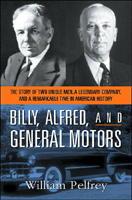 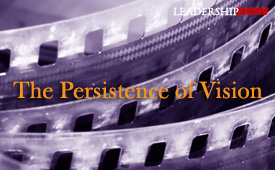
The Persistence of Vision MICHAEL MCKINNEY 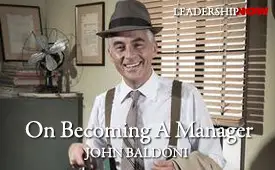
On Becoming A Manager JOHN BALDONI 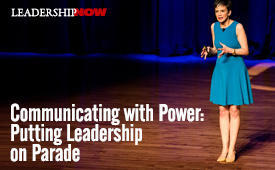
Communicating with Power: Putting Leadership on Parade KEVIN DALEY 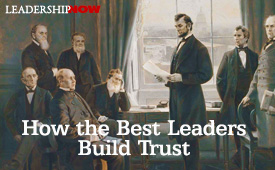
How the Best Leaders Build Trust STEPHEN M. R. COVEY 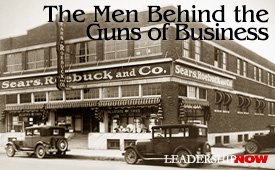
The Men Behind the Guns of Business RICHARD W. SEARS 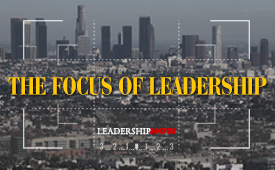
The Focus of Leadership MICHAEL MCKINNEY 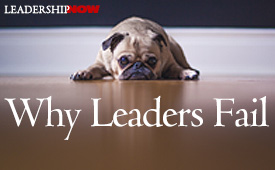
Why Leaders Fail MARK SANBORN |
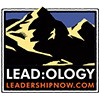 |
| ||
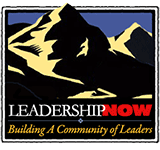 | © 2019 LeadershipNow All materials contained in https://www.LeadershipNow.com are protected by copyright and trademark laws and may not be used for any purpose whatsoever other than private, non-commercial viewing purposes. Derivative works and other unauthorized copying or use of stills, video footage, text or graphics is expressly prohibited. |
||